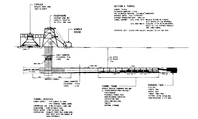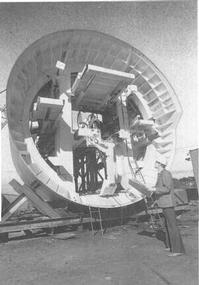


Chapter 6
I Construction During The Settlement Years
II The Use Of Timber As A Structural Material
III Structural Steel
IV Concrete Technology
V Housing
VI Industrialised Pre-cast Concrete Housing
VII Ports And Harbours
VIII Roads
IX Heavy Foundations
X Bridges
XI Sewerage
i Hydrogen Sulphide (HS) Attack
ii Property Services
iii Sewerage Reticulation
XII Water Engineering
XIII Railways
XIV Major Buildings
XV Airports
XVI Thermal Power Stations
XVII Materials Handling
XVIII Oil Industry
XIX The Snowy Mountains Scheme
XX The Sydney Opera House
XXI The Sydney Harbour Bridge
XXII Hamersley Iron
XXIII North West Shelf
Sources and References
Index
Search
Help
Contact us

For medium-to-hard ground, including hard basalts, tunnel-boring machines have been manufactured, mainly in the USA, to excavate tunnels in the range 2 m to 4.8 m diameter. Australian engineers have contributed substantially to the development process of these machines (Fig. 38).

The development of pressed and fabricated mild steel tunnel liner plates and precast concrete liner blocks by industries in the 1960s and 1970s did much to improve the construction methods achieved in soft ground tunnelling. Safe working practices generally and operations under compressed air particularly were also significantly improved in this period (Fig. 39).

The writer acknowledges the support received from the Office of the Director of Engineering, Melbourne and Metropolitan Board of Works, Mr. N. B. Smith and in particular the assistance of Mr. Donald Sellar.
Sewage
While the actual construction, as distinct from treatment technology, of sewerage and waste water plants has not resulted in any striking innovations, the real applications for innovative and adaptive technology in the sewerage field have been in the distribution systems.
This involves the delivery of raw sewage to the treatment plants and distribution of the treated products through outfall systems. Tunnels of brick barrel arch type design were common in the early days and served our major metropolitan areas very well, the products being delivered by impressive steam powered pumping stations. These have been replaced by concrete lined tunnels and sophisticated, though orthodox, pumping stations of the type which may be seen at the Carrum Waste Water Treatment Plants in Victoria.
On the other hand, ocean outfalls have frequently presented significant construction problems, particularly in the crossing of the surf zones of seabed installations on exposed coast lines.
At the present time, the Metropolitan Water Sewerage and Drainage Board in New South Wales is constructing two major submarine outfalls at Malabar and North Head. Full face tunnel boring machines are being employed and the tunnels will be lined with precast concrete segments. The Malabar tunnel extends 4 km out to sea, is of finished diameter 3.5 m and will be 150 m below the seabed. Water depth at end of the tunnel will be approximately 45 m. Effluent will be diffused through 28 predrilled rises.
Organisations in Australian Science at Work - Metropolitan Water, Sewerage and Drainage Board N.S.W.
People in Bright Sparcs - Robertson, A. G.
 |
Australian Academy of Technological Sciences and Engineering |  |
© 1988 Print Edition pages 365 - 366, Online Edition 2000
Published by Australian Science and Technology Heritage Centre, using the Web Academic Resource Publisher
http://www.austehc.unimelb.edu.au/tia/366.html